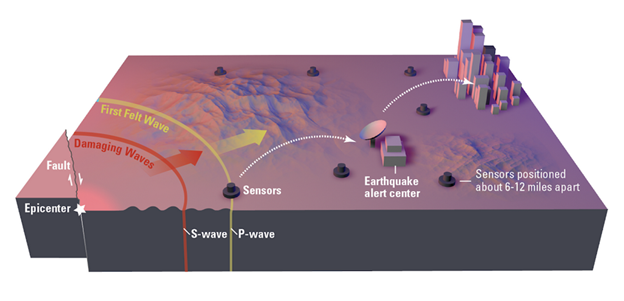BART, early adopter of Earthquake Early Warning System, shares learnings with other agencies around the country
When an earthquake strikes, every second counts. That’s why BART developed technology that leverages the U.S. Geological Survey-managed ShakeAlert Earthquake Early Warning (EEW) System, which was built through partnerships with the California Governor’s Office of Emergency Services (Cal OES), U.S. Geological Survey (USGS), and Berkeley Seismology Lab that sends an alert to BART servers warning the system of an impending quake, giving patrons and staff crucial seconds to “Drop, Cover, and Hold On” before shaking starts. Now, BART is sharing its learnings with other organizations around the world.
“The EEW system can give us that precious few seconds to reduce the possibility of derailment by holding the train or reducing the train speed and moving the train to a safer location,” said Phoebe Cheng, Group Manager of Civil, Structural, Track Engineering, & Construction Engineering at BART.
BART has a robust Earthquake Emergency Response Plan and holds multiple drills each year to properly prepare staff to respond. In the event of an earthquake, riders are advised to listen for instructions from BART personnel, as employees are trained to evacuate the public from dangerous areas.
The BART EEW server calculates the earthquake’s seismic intensity within nanoseconds, and if the seismic intensity -- or MMI (Modified Mercalli Intensity Scale) -- is greater than IV, the server will automatically signal trains to reduce speeds.
Upon notification, BART trains are held for at least five minutes before entering “manual mode” and slowing down to about 27 miles per hour. (Trains typically operate under Automatic Train Operations at speeds of up to 70 miles per hour.)
If the earthquake magnitude, Mw, is low, BART trains quickly return to regular speeds before the five-minute period is over. If the earthquake magnitude is high, train operators will either hold the train in place until authorized to proceed or will navigate the trains to the next closest station at a slow speed. Track inspections is conducted in all areas to check for damage to trackway and supporting structures. Once given the all clear, BART’s Operations Control Center will instruct trains return to normal operation.
BART began developing and testing the EEW in 2012 and joined the ShakeAlert Pilot Program in 2017. In 2020, BART became a Licensed Operator (LtO) of the technology.
“BART is certainly leading the way in this space,” said Jose Lara, the Chief of the Seismic Hazards Branch at the California Governor’s Office of Emergency Services.

Graphic courtesy of Cal OES.
Here’s how the groundbreaking technology works: Ground motion sensors placed throughout the state detect earthquakes before shaking reaches humans. There are two kinds of waves during an earthquake: P-wave and S-wave. P-wave rarely causes damage and travels faster than S-wave. The sensors detect the P-wave and transmit the data to the earthquake alert center, which determines the location and magnitude of the earthquake. The difference in timing between the two waves allows the sensors to estimate how much time each location in California will have before they feel the damaging S-waves.
All California residents will receive an alert on their smartphones if an earthquake hits with a magnitude of 5.0 or greater and an MMI of IV or greater. To receive an alert for an earthquake of 4.5 magnitude and above, individuals must download the MyShake application, available for Android and iOS.
BART’s EEW system is tested on a quarterly basis, Cheng said. During these drills, which occur during revenue service, a BART server creates a “scenario earthquake” that triggers the EEW system and signals trains to automatically decelerate.
In 2014, a 6.0-magnitude earthquake struck near Napa around 3:20 a.m., and the EEW system worked exactly as expected.
“Although there were no trains running at 3:20 a.m. when the earthquake happened, our automated train-stopping system did successfully activate when the warning was received,” Cheng said.
As an early adopter, BART has been actively working with other agencies and organizations to help implement and improve the system, including MetroLink, Oregon DOT, the Port of Seattle, British Columbia, and the San Francisco International Airport. BART has also provided USGS “a lot of feedback to improve the EEW system,” Cheng said.
“BART’s participation has helped to inform how the system can improve,” said Lara. “It’s actively played a role in providing feedback.”
In 1989, after the deadly and destructive Loma Prieta Earthquake, BART was widely heralded as the Bay Area’s lifeline post-disaster. The system was up-and-running shortly after the earthquake struck, and there was no major damage to the system.
“EEW technology has made the BART system safer and more resilient,” Lara concluded.
For more information about earthquake safety at BART, visit bart.gov. For information about Earthquake Warning California, visit earthquake.ca.gov.